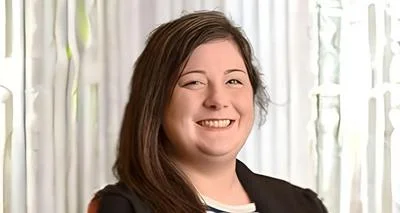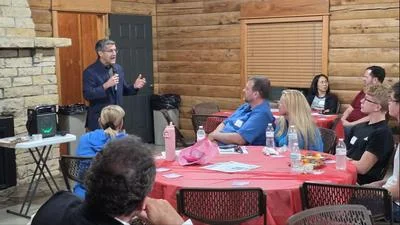Kathleen Lorenz - Board Member | Town of Normal
Kathleen Lorenz - Board Member | Town of Normal
Town of Normal Historic Preservation Commission met Aug. 13.
Here are the minutes provided by the commission:
Historic Preservation Commission 1 August 13,2024
Members Present:
Chris Niebur, Robert Porter, Larry Schumacher, Justin Vickers, Kathy Burgess
Members Absent:
Nancy Armstrong
Others Present:
Associate Planner Tessa Ferraro, Office Associate Hannah Neal, Assistant Corporation Counsel Kevin Sheahan
Call to Order:
The meeting was called to order at 12:30 PM by Ms. Burgess.
Approval of Minutes:
Mr. Porter moved to approve the minutes from the previous meeting on July 9, 2024. Mr. Schumacher seconded.
Public Hearing:
a. Election of Chair and Vice Chair
Ms. Ferraro held the election for Chair and Vice Chair.
Mr. Schumacher nominated Ms. Burgess for Chair and Mr. Niebur seconded. Ms. Ferraro called for a vote,
All in favor: 5
Opposed: none
Ms. Burgess was appointed as the new Chair for the Historical Preservation Commission
At this time the nominations for Vice Chair were heard. Ms. Burgess nominated Mr. Neiber and Mr. Schumacher seconded. Ms. Ferraro called for a vote.
All in favor: 5
Opposed: none
Mr. Nieber was appointed the new Vice Char for the Historical Preservation Commission. b. CA-24-08-23: Retaining walls in front yard, 10 Clinton PL
Mr. Schumacher made a motion to approve the certificate of appropriateness and Mr. Vickers seconded.
Ms. Ferraro noted that the contractor had joined the meeting virtually and went on to review the report. 10 Clinton Place is a non-contributing property in the Ceder Crest Historic District. The applicant would like to install two sets of retaining walls along the front property line. The proposed material would be a stone paver.
The contractor added that the wall would be partially for aesthetics, but also to help remove the need to mow the area because it is so steep. This addition would cause no negative effect on the property's drainage.
Mr. Porter asked what the width of the lawn was.
The contractor said that the length would be roughly 60 feet, running along the sidewalk to the applicant's property line. The width would be as low as 3 feet on the bottom end, and the top would grade into the landscaping at the top of the steps.
Ms. Ferraro clarified that it would be 60 feet on either side of the stairs.
The contractor added that it would be between 3 and 4 feet high, to meet code requirements.
Ms. Burgess said there had been some discussion between her and Ms. Ferraro as to whether this project could be expedited, as it could be considered landscaping. They ultimately decided the commission should review the proposal as well since it is similar to a fence and could be considered a new structure.
The contractor said that the plan would be to get the wall done this year, and then the homeowner would focus on adding landscaping in 2025.
Ms. Burgess asked if there were any comments from the commission. She also stated that while this house was technically noncontributing, it was built in 1959 and did have a distinct architectural style.
Mr. Vickers said that he had some concerns about the type of block that had been selected. He feels that compared the mid-century brick that was used to construct the house, the proposed brick looked too modern and speculated that it could have been picked up at any local retailer.
The contractor said that they use a specific landscape supplier for the proposed material, and that the type of block is common.
Mr. Vickers said regardless of the material vendor, the brick still does not look architecturally significant compared to the house.
The contractor said that this brick was the most economical and that there were different color options available.
Mr. Niebur said that he had looked over the options for the brick prior to the meeting and noticed that there were two different profiles for the brick. One looked to be roughly 6 inches high and the other is about 3 inches high. He asked the contractor which one he’d planned on using.
The contractor said they were planning on using the 6-inch blocks.
Mr. Niebur said that he had concern with using a 6-inch block because it looks to similar to a concrete block, making it look like a cheaper material.
The contractor said that the block is meant for retaining walls and the 6-inch would be more durable.
Mr. Niebur said that while durability was important, the Commission’s purpose was to make sure the material complimented the historical features of the neighborhood.
The contractor said that he could send some different options, but the homeowner would need to approve the possible budget increase.
Ms. Burgess said that the “cap” shown in one of the example photos looks too modern. A limestone cap would be more appropriate.
Mr. Niebur said that the block walls are meant to be easier to build. The house being discussed is newer, which makes it impossible to build out the wall using the same brick that had been used to build the house.
The contractor added that the property overall needs some kind of landscaping and that the wall would help add curb appeal.
Ms. Burgess asked if there were any options that were linier, longer, or not quite as high. She added that even though the property is currently noncontributing, it may be in the future. Therefore, she would like to see other options.
Mr. Portor asked if this work was meant to begin in October and the contractor said yes. Mr. Niebur said that they don’t want to use a product that’s not appropriate for the homeowner's sake The contractor said that the other options available would be glued and have pins to hold them together. He said the other options would also be smaller and not necessarily hold the grade.
Mr. Schumacher asked if they were looking at a specific color. He was curious if they were perhaps trying to match the house or the cement.
The contractor said that the color had not been determined yet.
Mr. Schumacher asked if limestone would be possible.
Ms. Burgess added that doing it with concrete cap might also be a good solution. She asked if there was a way to build the wall economically out of concrete and face it with a material that might provide more options.
Mr. Niebur said that it could possibly be done with hollow concrete block with brick facing but it would be more expensive. It would also require a concrete footing. Mr. Nieber added that it might be tricky to find a brick that would compliment the house.
Mr. Niebur asked if the height of the low wall was meant to hit the middle step.
The contractor said that would be the intent. He mentioned that they gave the homeowner an option to build with a boulder wall, but they wanted to use the block instead.
Mr. Nieber asked if that meant that the wall would end up being taller than the top step. The contractor said that it wouldn’t be drastically taller, maybe less than 6 inches.
The contractor said that regardless, the homeowner needs the landscaping redone. He offered to talk to the homeowner and see if the landscaping could be done first and then the wall could be revisited.
Ms. Burgess said that she didn’t want the homeowner to change the phasing of their project, but that the Commission would need to see other materials.
Ms. Ferrero said that the contractor could submit the new material options to her and then the Commission could carry the agenda item over to the September meeting.
The contractor agreed to rebid the project with new material and revisit.
Ms. Ferraro specified that the whole commission would need to look at the materials, so an expedited review would not be possible before the next meeting.
At this time, Ms. Burgess called for a vote.
All in favor: None
Opposed: 5
The motion did not pass.
c. CA-24-08-24: Backyard deck. 618 N School
Mr. Porter moved to approve the Certificate of Appropriateness, and Mr. Nieber seconded.
Ms. Ferraro reviewed the proposal. The homeowner would like to install a deck to the north side of the garage. The deck would be roughly two feet in height and would not have any railings. It would not be visible from School Street but would possibly be visible from Gregory.
Ms. Burgess asked if the homeowner had any comments.
The homeowner said that they would be using cedar decking material. The furthest corner would be about 24 inches off of the ground. The code requires 30 inches for a railing.
With no further discussion, Ms. Burgess called for a vote.
All in favor: 5
Opposed: None
The Certificate of Appropriateness is approved.
d. CA-24-08-25: Window replacement, 11 Broadway Pl
Mr. Nieber moved to approve the Certificate of Appropriateness and Mr. Porter seconded. Ms. Ferraro noted that the contractor was present, and that the homeowner was joining virtually.
The contractor provided a brief description of the project. Overall, the homeowner is requesting to replace six windows. The homeowner is wanting to add grids on the upper and lower sashes. Currently the grids are just on the top of the windows.
Ms. Burgess asked if they had asked if there were options available without the muntin pattern on the bottom.
The contractor said that the windows had already been purchased, and it could possibly be an option.
Ms. Burgess had concerns with altering the grid pattern, that she would like to see it altered on one of the windows that had not been included in the proposal. She also added that the commission would prefer to see the windows be restored, instead of replaced. She asked the commission for their thoughts on altering the grid pattern on the windows.
The contractor interjected and said that restoring instead of replacing would be a temporary fix and would require more effort and money.
Ms. Burgess said that there is grant money available to assist with cost. The Commission is charged with saving historical architecture whenever possible. She also stated that the replacement window did not have consistent sizing to the original.
Mr. Nieber added that restoration and preservation are important, and replacement should only be an option if preservation is not possible. If the house was built a certain way, it would need to be consistent.
Mr. Vickers added that it is possible to replicate the current windows.
Mr. Niebur said that the windows should not have been purchased prior to the Commission’s approval. Ms. Ferraro opened up the Marvin estimate that showed a diagram of the proposed windows.
Mr. Schumacher said that he liked the original design of the windows and felt that the proposed design looked too busy.
Mr. Vickers said that the proposed design would be a cosmetic alteration entirely different from the original architecture’s intent.
Ms. Ferraro added that there was a proposed change to have one window along the south side of the house to be an awning window instead of a double hung window. The grill pattern would span the entire window.
Mr. Niebur said that the double hung window is difficult to see from the street.
Ms. Ferraro said that the window was already unique to the other windows because it is on a different level of the house.
Mr. Porter asked if the homeowner had any comment, with no response
Mr. Niebur asked if the decorative pieces were adhered to the glass, meaning they could possibly be removed, creating a simulated divided light. In the past, this has qualified for conditional approval.
There was some discussion about the bigger window in comparison to the rest of the windows. Ms. Ferraro passed around a sample photo for clarification.
Ms. Burgess made a motion to modify the approval subject to the condition that the bottom section of the window would be free of any decorative trim, with the exception of the awning window, which would have a bottom muntin.
Mr. Vickers seconded.
Ms. Burgess called for a vote.
All in favor: 5
Opposed: none.
The motion received conditional approval.
e. BG-24-08-08: Grant for window replacement, 11 Broadway Pl
Mr. Vickers made a motion to approve the Bone Grant, and Mr. Porter seconded.
Ms. Ferraro said that the labor cost and material cost were missing from one of the estimates. Once she receives those materials, she would apply the final grant total to the lowest of the two estimates. She added that they could make the grant approval contingent on the lowest estimate once all information had been received.
Ms. Burgess said that as long as the design adjustments maintain the same cost and called for a vote. All in favor: 5
Opposed: none.
With no further business the meeting was adjourned at 1:25 PM
https://www.normalil.gov/ArchiveCenter/ViewFile/Item/5056






 Alerts Sign-up
Alerts Sign-up